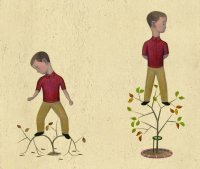Redefining Failure
Why encouraging students to get everything right is the wrong direction.
As educators, we understand conceptually how failure can help students learn, but do we really believe it? I think that if we did, we might build failure—in a significant way—into the scope and sequence of our curriculum. (It’s true that when state testing season is upon us the word failure is hardly permissible, but let’s talk about it anyway.) What would our classrooms perhaps look like if we were to allow for more failure—and even embrace it?
Failure in the Classroom: What It Looks Like
For starters, a classroom based on failure would encourage routine trial and error. When we teachers plan ahead for there to be failure, we create time for students to flounder, take missteps, or even totally fail. Inquiry-based learning uses failure to its best advantage. Inquiry is a learning activity in which the solution or end result is not known beforehand—even the teacher is unsure of what students will come up with.
Teachers who are designing inquiry-based learning for their students take the essential feedback from failure and make sure there are multiple opportunities for students to improve. This is often done in a low-stakes or formative way, allowing students to practice and do better. For example, it only takes a few gutter balls before someone learning to bowl will be able to send the ball down the middle of the lane. A handful more practice throws and that bowler may experience the thrill of a strike. Each time that beginning bowler rolls the ball, the iterative act gets him closer to his goal.
Teachers not fearful of failure can encourage students to take risks, recognizing from the start that some of those risks will move students to the next level of learning.
Before the next iteration of the learning process, a teacher who embraces failure will teach students to begin the learning-from-mistakes process by asking not just “How did the project, paper, or plan fail?” but also:
- “Why did it fail?”
- “Was the approach flawed from the initial concept?”
- “What was not flawed?”
- “What is your next step, and what will you adjust or keep the same?”
Wicked Problems
Teachers who espouse failure in their classrooms also relish “wicked problems”—those really difficult problems that are seemingly impossible to solve. Failure-friendly teachers know that a group of students has a much better chance of successfully tackling wicked problems than a student working solo (regardless of her smarts) because of the synergy of multiple viewpoints—different students tackling the same problem together. Thus, students working together with a collaborative spirit is key.
I believe that truly embracing failure in our classrooms is an antidote to shallow learning. For example, students in difficult math classes in Finland are expected to fail horribly at first, and the students and teachers don’t freak out about it. The students are given time and support to learn from their mistakes and make corrections. They understand that always getting the problem right or getting it right from the very start is not a prerequisite for success.
The Power of Failure
Teachers open to students failing will teach them to apply the process of “plan, do, study, act.” For example, when solving a wicked math problem, students would first name the problem (drawing a picture if necessary) and plan a first step. Then, in do, they work the problem with that plan and see how far it will go. Students then study their progress and if they’re on the right track, continue; otherwise they start over on a different path. Next, they ask others what they did and get more information, while also looking at examples of similar problems. Finally, they act—to either complete the problem or start over with a different approach. This is a messy process, yet this is what real learning is all about.
When we teachers adopt and practice the power of failure in our classrooms, a low mark on a paper or project will no longer signify defeat and despair to our students. Instead it will signify an opportunity to go back to concept and discover the error in thinking. This encourages students to work together and engage in the iterative learning process of taking failure and making it a success. In my experience, this increases the quality of the products because students (and teachers) don’t settle for good enough.
Creating a space in the classroom for failure also encourages students to approach solving problems in nonlinear ways, using multiple possibilities for refining their thinking.
